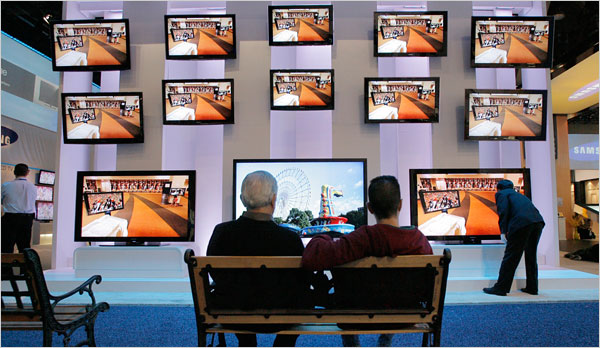TV Buying Guide for 2015
/Image Source: NYTimes
It can be an exciting and slightly confusing time when it comes to buying a new TV. You’ll be faced with questions like, “What’s the right size?”, “What’s an OLED?”, “Why is this TV curved?” and more. We hope to give you the answers you seek to make the process of choosing your new TV as easy as possible.
What size is right for me?
Everyone has the different idea when it comes to size, so it’s not an easy question to answer. You need to consider the size of the room, how far away you want to sit and the type of experience you want (i.e. a TV in the kitchen versus a TV for a home theatre). Generally most people tend to prefer a larger TV if it’s in their budget, as the old saying goes “bigger is better”. To help you out, here are our recommendations on what size is right for you.
How far away will you be sitting?
A great place to start thinking about what size screen you should get is to figure out how far away you will be sitting from it. As a rough guide, the minimum distance you should sit is 1.5 times the diagonal width of the screen. Double this if you want a recommended maximum distance. Measuring your room before you head to the shop to look at TVs could save you a big headache (pun intended).
65 - 90 inches
This Extra Large range is often used for media rooms, to give that immersive experience watching movies, sports or playing video games.
50 – 64 inches
Large TVs that give a strong visual impact for any room, and is commonly seen within living rooms.
33 – 49 inches
Medium TVs tend to work exceptionally well in average sized living rooms and bedrooms.
32 inches and smaller
The small TV range is often chosen for bedrooms, kitchens and for casual viewing.
What is Resolution?
A television resolution is determined by the number of pixels that make up the picture on the screen. Pixels are the individual blocks of light built into the screen. The two common resolutions for most TVs are 720p and 1080p, and may be listed on the TV as “1366 X 768” (720p) or “1920 X 1080” (1080p) pixels. There is also a new resolution TV on the market known as 4K, and is made up of “3840 X 2160” pixels. For an in-depth guide on resolution and 4K, click here.
Different types of TV technology
Plasma
Plasma display panels (PDPs) televisions offer good picture quality with great colors and deep blacks, with wide viewing angles. It is also one of the few televisions that does not have visible motion blur, ensuring that you don’t miss any action. Plasmas have their cons though, they are heavier and consume more power than the rest on this list.
LCD TV
Liquid Crystal Display (LCD) is a TV set that is permanently backlit. This is due to LCDs being a transmitted display technology, meaning that LCDs don’t produce their own light. LCDs produce an image on its screen by having its pixels backlit by a separate lighting source, often using Cold Cathode Fluorescent Lamps (CCFL). As a result of using CCFL, the LCD TV gives nice colors and brightness, along with a decent contrast, however they cannot achieve pure black. These TV sets are often found at affordable prices and are relatively slim, but not as slim as an LED.
LED TV
Light emitting diode (LED), also known as an “LED-backlit LCD display” is a flat screen television set that uses LED backlighting instead of CCFL (cold cathode fluorescent lamps). This means that each pixel is individually lit. This enables the TV to achieve deeper blacks and brighter images, giving higher contrast ratios. LED TVs also tend be slimmer, offer wider viewing angles than LCDs, and are more energy efficient. The LED TVs are a very popular option due to thier excellent picture quality, and work well within lit rooms.
OLED
Organic Light Emitting Diode (OLED) Television screens are considered to effectively be the unification of the plasma, LCD and LED displays. With OLED TVs, you get improved colour accuracy, with colour almost looking lifelike in quality. It has incredible viewing angles, as the image remains to be sharp and clear as you move away from the centre of the screen. As it doesn’t run on backlighting, it makes the OLED TV very energy efficient with low power consumption. What makes these TVs truly exceptional is that each of the millions of pixels is clearly individually illuminated, giving its fantastic range of color and true blacks.
Features you may want to consider
Smart TVs
Smart TVs have a built in interface that will enable you to access apps, such as Facebook and Netflix, browse the Internet, and stream Internet videos straight to the TV, without requiring any additional accessories. This is a more common feature in newer TV sets, and they will often be labeled as a “Smart TV”.
3D TVs
A 3D TV has the ability to deliver video content into stereoscopic 3D, provided that you use the 3D glasses that come with the set, giving you the thrill that you receive when watching movies in 3D at the cinema. You can still watch TV in standard mode as well. Since 3D glasses are required to enjoy 3D experience, you may want to buy a few extra pairs if you plan to watch with company.
Curved TVs
A curved TV is the latest design in the TV industry, and come with some neat features. Primarily a more optimum viewing experience, provided that you are sitting at the centre of the screen. Most of these TVs are capable of handling the new 4K resolution and give a cinema like experience at home. Just be aware that curved TVs are very difficult to be wall mount, and may make it difficult to have a large viewing group.
Is there anything else to consider?
One thing to consider is the number of HDMI ports on the TV, as that will determine how many devices you can connect. It is recommended that you have at least 3, so that you can have a few options. You may also want to have a look at getting a few accessories, such as a universal remote (you may want to have a look at our recommendation of the NEEO), as well as a surround sound system, (you'll want to ensure that the sound quality matches that brilliant new picture quality).












